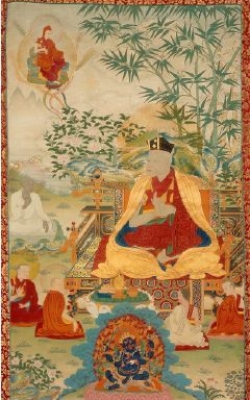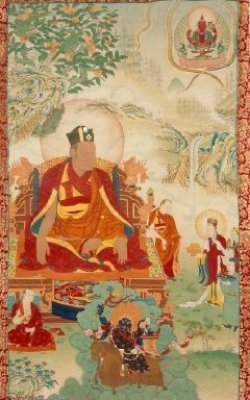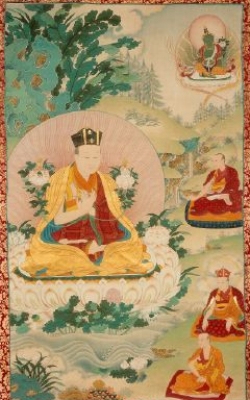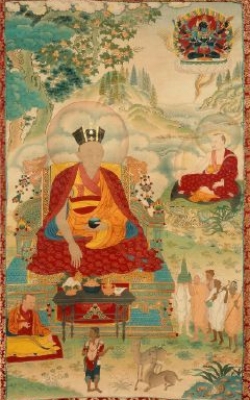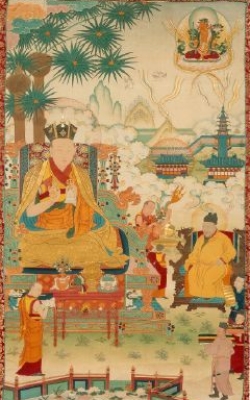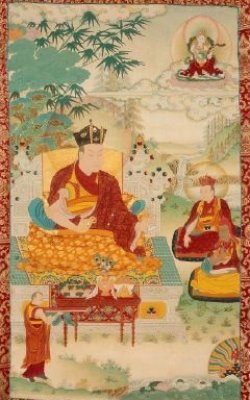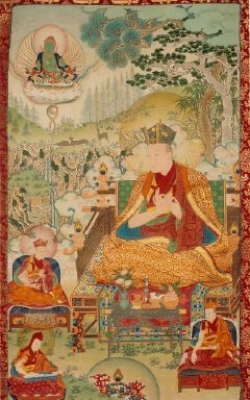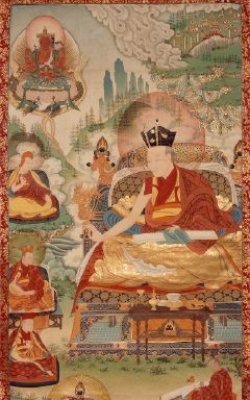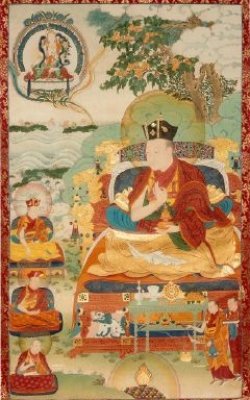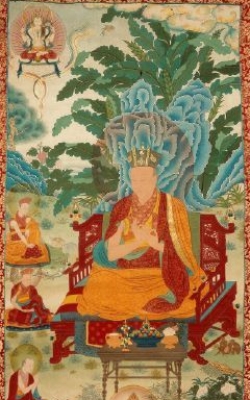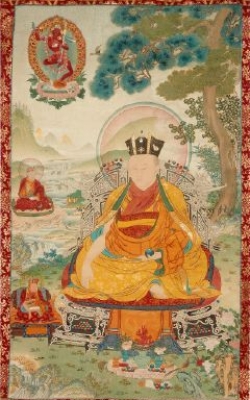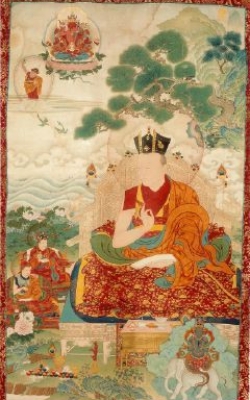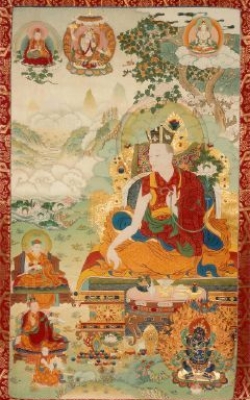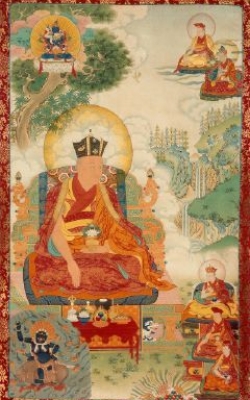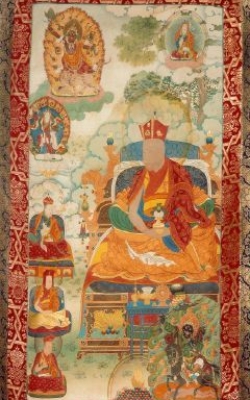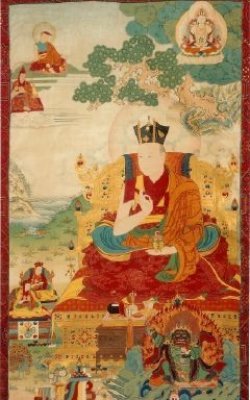Karmapa III - Rangjung Dorje
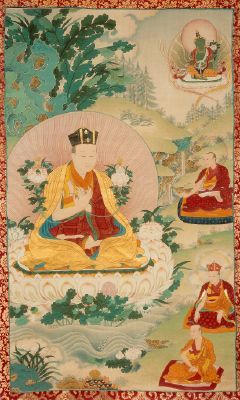
THE IIIrd KARMAPA
(1284 - 1339)
On the eighth day of the first month of the year of the Wood Monkey (1284 C.E.) the third Karmapa incarnation, Rangjung Dorje, was born in the Tingri area of western Tibet. It is said that as his mother gave birth to him, the moon was rising and the baby immediately sat up saying, "The moon has risen."
The young Rangjung Dorje displayed extraordinary precocity. One day, at the age of three, while playing with friends, he suddenly asked them to make him a throne. When the imitation throne was constructed, he sat upon it, put on a black hat and announced that he was the Karmapa Lama.
Soon news of this remarkable child traveled far and wide, reaching the attention of Lama Urgyenpa. This Drukpa Kagyupa lama requested that the now five-year old Rangiung Dorje be brought to see him. The spiritual qualities of the young child led Urgyenpa to realize that this was indeed the incarnation of the Karmapa. To renew the relationship between them, Lama Urgyenpa then bestowed the empowerments of Cakrasamvara and Hevajra upon Rangjung Dorje.
The education and training of the new Karmapa began at the age of seven, when he received the novice ordination from Lama Kunden Sherab. Following this he was formally enthroned as the Karmapa Lama at Tsurphu. His training continued at Tsurphu, where for eleven years he studied the complete teachings of the Kagyu and Nyingma traditions from Lama Nyenre Gendun Bum and Lama Namtshowa. The former saw Rangjung Dorje as an embodiment of Saraha, the great Indian tantric saint. He completed this intensive period of study with a meditation retreat in the vicinity of the great "Lady of the White Snows", Jomo Gangkar, known elsewhere as Mount Everest.
At the age of eighteen, Rangjung Dorje traveled to the great Kadampa monastery of Sangphu, where he received the full ordination from the abbot, Sakya Zhonnu. He remained for some time at the monastery, engaged in a wide study of philosophy, logic and religious law. His studies included the vinaya, thought transformation - བློ་སྦྱོང་།, The Five Texts of Maitreya - འབྱམས་ཆོས་ལྡེ་ལྔ་། Madhyamaka philosophy, Abhidharma, and the Prajnāpāramitā sutra and Sāstra commentaries.
The third Karmapa was an omnivorous student. Although he retained understanding from his previous lives, he researched all aspects of both contemporary and traditional learning. He received teachings from the most profound scholars of his day. As an example of this, some of the teachings he received from Lama Kunga Dondrup are particularly noteworthy, viz:
- Kālacakra Tantra: root text and commentary
- Guhyasamāja Tantra
- Cakrasmpvara Tantra: root text and commentary
- Yamāntaka teachings.
- Vajramālā teachings
- Hevajra Tantra and commentaries
- Sampulika
- Guhyagarbha teachings
- The peaceful and wrathful deities" teaching Shi Jaypa teachings of Dampa Sangyay
- Machig Labdron's chöd teaching
- Sakyapa path and fruit teachings
- The ydahga yoga of Kālacakra
- Kangyur and Tenjur textual transmission
- A comparative study of Hindu philosophy
When Rangjung Dorje received the empowerment of Kālacakra, he had a visionary experience of the entire universe as contained within the body itself. Inspired by this, he composed a very influential text on astrology.
When this period of study with Lama Kunga Dondrup was completed, Rangjung Dorje entered intensive meditation at the Garuda Castle retreat center near Tsurphu. During this retreat he had a dream in which the teachings of the philosopher Nāgārjuna were conveyed to him by his late guru, Urgyenpa. Rangjung Dorje's studies extended into the medical field.
From Lama Bare he received the Sowa Rikpa medical education. Subsequently, the Karmapa stayed for a while with the learned Abbot Tshultrim Rinchen, from whom he received teachings, among which are the following:
- Guhyasāmaja Tantra
- Madhyamaka philosophy
- Mahāmāyā Tantra
- Hevajra teachings, from the lineage of Ngok Chödor and Metön Tsönpo Yamāntaka Tantras
- Cakrasamvara Tantras.
Later, Rangjung Dorje studied with Rigdzin Kumārarāja, the most important contemporary exponent of the innermost essence (Tib.: snying. thig) teachings of the Nyingmapa tradition. These teachings, which had been introduced into Tibet in the eighth century by thepavdita, Vimalamitra, reveal the direct experience of buddhahood through the nakedness of awareness. They had a lasting influence on Rangjung Dorje. In meditation he had a vision in which Vimalamitra was absorbed into his forehead. The effect of this teaching on Rangjung Dorje led to his bringing together the two teachings of Kagyupa "great seal" and Nyingmapa "great perfection" into one stream.
Rangjung Dorje's depth and breadth of scholarship was of a degree usually associated with the European "renaissance man," and in Tibet with the later Rime ("boundaryless") movement. Having assimilated most of the Buddhist teachings, empowerments and textual transmissions, which had been brought to Tibet, he communicated his vision in many important texts. Of the ones surviving, the foremost for the Kagyu sect is the Deep Inner Meaning - ཟབ་མོ་སྣང་དོན། an invaluable commentary on the nature of tantra.
On the completion of his studies, Rangjung Dorje began to travel through southern Tibet, giving teachings and bestowing empowerments. He stayed in the Kongpo area for a period of three years. Many people were inspired to study dharma by the power of his presence and reputation as a dharma master.
In time, Rangjung Dorje's fame spread as far as the Mongol Emperor Togh Temur, who invited him to visit. He accepted the invitation and set out for China, but on the way his party was held up by unseasonable weather. The following spring the party again set out for China. On the way certain omens occurred which indicated to Rangjung Dorje that the emperor had died. Before continuing Karmapa performed the death rites for the emperor. The party finally arrived at the palace of Tai-ya Tu on the eighteenth day of the tenth month of the year of the Water Monkey (1332 C.E.). There it was learned that the Emperor Togh Temur had indeed died on the day of the omens. However, the royal family and court were still able to welcome Rangjung Dorje.
Karmapa advised the late emperor's younger brother, Toghon Temur, to wait for six months before ascending the throne and he predicted that Toghon Temur would prove to be a great monarch. On the fifteenth day of the first month of the Water Bird year the new emperor was enthroned by Rangjung Dorje in a grand ceremony.
In the year of the Wood Dog, Karmapa set out on the return journey to Tibet to procure, as a gift for the emperor, some long-life nectar - ཚེ་ཆུ།, left near Samye by Padmasambhava. On the way he established many monasteries dedicated to Kagyu dharma. Of especial importance is the temple that he established at Wu-tai Shan, the Five Peaks of Manjushri mountain in China.
On his return to Tibet, Rangjung Dorje was involved in teaching and resolving political problems. Subsequently, Karmapa received an invitation from Toghon Temur to revisit China. So, in the year of the Fire Rat, Karmapa set out once again for China. Throughout the long journey Rangjung Dorje continually taught dharma. Upon his arrival, the emperor welcomed him joyfully and received the gift of the tse chu from Karmapa which enabled him to live the longest of the Mongol emperors. During his stay Rangjung Dorje established a new Kagyupa monastery. He was also able to end the climatic difficulties which were harming the crops in China at that time.
On the fourteenth day of the sixth month of the year of the Earth Rabbit (1339 C.E.), Rangjung Dorje told the emperor of his presentiments of his own imminent death. He withdrew into the Cakrasamvara shrine, where he meditated on the heruka and passed away in meditation. The next day, as his final teaching to the emperor and empress, Karmapa appeared to manifest his face in the full moon.
Rangjung Dorje's influence on vajrayāna Buddhism was incalculable. As well as his invaluable texts, his teaching was spread through his many accomplished students. Rangjung Dorje taught the famous Sakya scholar, Yagde Pandita and the most profound Nyingmapa guru, Longchen Rabjampa. In addition, Rangjung Dorje's other students included Shamar Rinpoche, Drakpa Senge and Toghon Temur.
Reproduced with permission of the Very Venerable Karma Thrinley Rinpoche




